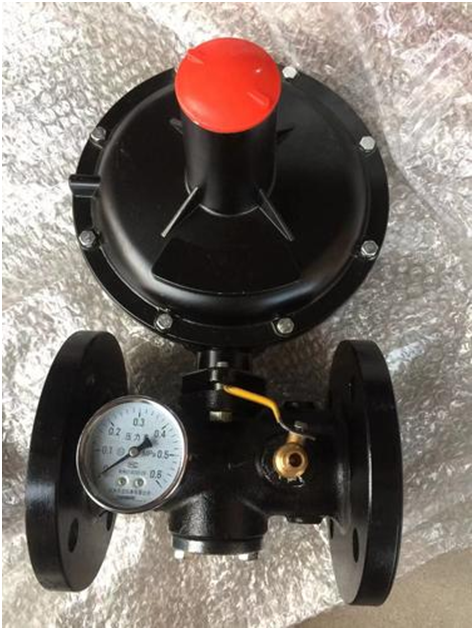Magpie Valve Selection: Accurate Matching Ensures Reliable Control
Valve Technology Sharing
Customization and Application of Natural Gas Pressure Regulators
Specialized Pressure Regulator for Industrial Furnaces: A Technical Breakthrough in 4MPa to 0.5MPa Gas Reduction
In industrial furnace combustion systems, the natural gas pressure regulator acts as the "energy conversion hub," and its performance directly impacts combustion efficiency, energy consumption, and overall operational safety. This article explores a highly specialized application, reducing 4MPa high-pressure natural gas to 0.5MPa at a flow rate of 200 m³/h. Although this represents a niche scenario characterized by an uncommon pressure ratio and medium flowrate, it reveals core technical challenges. Through analysis of working conditions, design logic, and safety strategies, we present a customized engineering solution for this type of pressure regulator.

Key Operating Challenges: Resolving the Tension Between "High Pressure Ratio" and "Stable Combustion"
Conventional single-stage pressure regulators are generally limited to a safe pressure ratio of ≤3:1 (e.g., 4MPa down to 1.3MPa). A reduction from 4MPa to 0.5MPa implies an 8:1 ratio, leading to two critical risks:
Cavitation Damage: Rapid pressure drop causes gas to vaporize and form bubbles, which implode and erode valve internals. Testing showed dense pitting (0.2–0.5mm deep) on valve seats after only 3 months.
Severe Pressure Fluctuations: Under variable furnace loads, single-stage outlets fluctuate by ±10% (e.g., 0.45–0.55MPa), leading to unstable flame behavior such as blow-off or flashback.
Although 200 m³/h appears moderate, it imposes strict design requirements on the valve's internal flow path:
If DN80 is used, flow velocity reaches 25 m/s (exceeding the ideal 20 m/s), generating noise levels up to 95 dB and potentially reducing valve lifespan.
If DN100 is used, low-load operation causes flow to drop to 8 m/s, increasing the risk of vortex formation and pressure instability.
First Stage (4MPa→1.5MPa):
Uses a piston-type module with a 3:1 pressure ratio, integrating a multi-perforated sleeve (50 holes, φ4mm) to dissipate energy and reduce cavitation by 70%.
Second Stage (1.5MPa→0.5MPa):
Employs a precision diaphragm module with 200 cm² effective area (2× conventional size), achieving ±1% outlet stability (0.5MPa±0.005MPa), ensuring consistent combustion (flame height fluctuation <50mm).
Tapered Flow Channels:
DN80 in the first stage (18 m/s) and DN65 in the second stage (20 m/s) with gradually narrowing channels prevent vortex formation. Measured noise: 85 dB, within industrial limits.
Surface Hardening Treatment:
Trim parts (disc and seat) coated via HVOF (WC-Co), achieving hardness of HV12004× wear resistance vs. stainless steel. Service life exceeds 4 years, up from 1 year (verified in a heat-treatment furnace).
Built-in Overpressure Shutoff:
Triggers at outlet pressure >0.6MPa (1.2× setpoint), closing in 0.8 seconds60% faster than the industry norm.
External Relief Valve:
Pilot-operated, opens at 0.55MPa, with relief flow of 500 m³/h (2.5× rated flow) for safe venting during fault events.
Leak Monitoring Integration:
Combustible gas sensors at inlet/outlet with 0.1% LEL sensitivity. Alarms are triggered if leakage exceeds 0.01% CV (actual leakage <1ml/min, far below API 598 VI limit of 9.75ml/min for DN65).
In one forging plant furnace upgrade:
Improved Combustion Efficiency:
Pressure stabilized at 0.5MPa±0.005MPa; flame temperature fluctuation <20°C. Heating uniformity improved, reducing scrap rate from 3% to 0.5%.
Energy Savings:
Consistent gas-air ratios maintained at 1:10.5. Gas consumption dropped from 80 to 72 m³/ton of steel, saving ~¥300,000 annually (based on 50,000-ton output and ¥3/m³ gas cost).
Though tailored to 4MPa→0.5MPa at 200 m³/h, the core technology is extendable:
Pressure Ratio Adaptability:
Multi-stage setups (e.g., 3-stage) can meet 5MPa→0.3MPa applications.
Flow Range Flexibility:
Internal diameters (DN50–DN150) cover flows from 50 to 500 m³/h, suitable for various furnaces like annealing and aluminum melting units.
China currently lacks technical standards for "high-ratio, medium-flow" gas regulators. This development provides data for future specifications:
Proposed Guideline:
Limit single-stage pressure ratio to 4:1 in multi-stage systems.
Proposed Outlet Stability Grades:
±1% for primary load furnaces, ±3% for secondary load.
With an integrated smart positioner and IIoT connectivity, the valve enables:
Real-Time Tuning:
Automatically adjusts valve opening to maintain outlet pressure when inlet changes (e.g., 3.8→4.2MPa prompts ±5% adjustment).
Predictive Maintenance:
Vibration and temperature sensors detect wear (e.g., disc displacement >0.1mm), extending maintenance cycles from 6 to 12 months.
Nickel-Based Forged Body (e.g., Inconel 718):
Tensile strength ≥1220MPa, withstands 10MPa pressure and 150°C, offering 4× erosion resistance over 316L stainless steel.
Sealing System:
Dual bellows + flexible graphite withstands 1.5× rated pressure (6MPa) with zero leakage, life span exceeding 10 years.
The "niche" nature of this gas pressure regulator lies not in market marginality, but in its specialization for unique operational conditions. Reducing 4MPa gas to a stable 0.5MPa flow through two-stage precision control showcases mastery over pressure ratio management, flow dynamics, and safety assurance. Such solutions elegantly resolve the "last mile" challenge of furnace combustionensuring every cubic meter of gas contributes optimally to energy conversion.
In industrial equipment, "niche" means "tailored precision." Customizing a valve for one furnace lays the groundwork for industry-wide technical standards. True industrial progress is often hidden in these seemingly rare-use products, embedded in our uncompromising pursuit of every operational detail.
If you're exploring customized solutions for non-standard valve applications, we welcome collaboration, transforming niche demands into innovation starting points and delivering perfectly matched solutions for every unique scenario.
